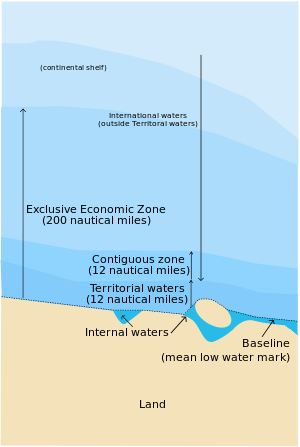Internal waters

A nation's internal waters include waters on the landward side of the baseline of a nation's territorial waters, except in archipelagic states.[1] It includes waterways such as rivers and canals, and sometimes the water within small bays. According to the United Nations Convention on the Law of the Sea, the coastal nation is free to set laws, regulate any use, and use any resource. Foreign vessels have no right of passage within internal waters, and this lack of right to innocent passage is the key difference between internal waters and territorial waters.[2] The "archipelagic waters" within the outermost islands of an archipelagic states are treated as internal waters with the exception that innocent passage must be allowed, although the archipelagic state may designate certain sea lanes in these waters.
See also
- United Nations Convention on the Law of the Sea
- Freedom of the seas
- Baseline (sea)
- Exclusive economic zone
- Continental shelf
- Seasteading
- International waters
- Canadian Internal Waters